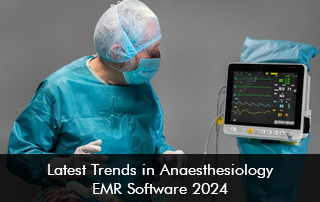Electronic medical records (EMR) software provides a simplified method of storing and retrieving healthcare data. It acts as the digital repository for patient medical records. Healthcare workers can safely store a variety of patient data, including demographics, extensive clinical data, medical and social histories, lab findings, and more, with specialized software solutions.
Anesthesiology Electronic Medical Record Features:
Electronic Medical Records software ( EMR) with a focus on anesthesiology provides customized templates that are intended to address the particular requirements of anesthesiologists. These templates include all of the keywords and diagnoses that are used daily in practice, making documenting simple and guaranteeing thorough documentation.
Here are the key features of Anesthesiology EMR:
- Pediatric and young Patient’s Anesthesia.
- Obstetrical anesthesia.
- Heart-related ( Cardiac) anesthesia.
- Potential Problems with Health.
CD/CPT Codes Integration:
- The chore of looking up updated disease codes from the CDC is taken care of for specialists by electronic medical records software.
- Doctors no longer have to manually seek relevant codes thanks to regular revisions that guarantee the code list stays up to date.
Integration of Equipment:
- Patients under anesthesia have sensitive bodies, thus their vital signs are continuously monitored.
- Critical care monitoring devices, such as those that measure blood pressure, oxygen saturation, heart rate, and other parameters, are integrated with anesthesiology EMR software, which also records physiological information.
- The data is automatically stored by the software in patient files.
Anesthesiology: Optimizing Workflow Management
- A specialty that involves large volumes of data must be recorded and stored with efficiency using EMR software.
- Physicians should be able to obtain thorough understanding of patient situations and make prompt, well-informed judgments with expert management, documentation, and organization of all anesthesiology-related paperwork.
Surgical Time Calculator:
- Accurate time is essential for ensuring patient safety and effectiveness during surgeries due to their criticality.
- In order to reduce the likelihood of a patient awakening or feeling during operation while under general anesthesia, the time calculator—which is integrated into the EMR software—helps determine the proper dosage delivery and whether more doses may be required during procedures.
Anesthesia Management Dashboard:
- A top-tier electronic medical record system for anesthesiologists should have a dynamic, real-time dashboard that unifies patient charts, profiles, billing procedures, scheduling, and other features into a single interface.
- The streamlined dashboard maximizes productivity by removing the need to switch between tabs, giving doctors instant access to vital information.
Benefits of Anesthesiology EMR software:
Here are the key benefits of Anesthesiology EMR (Electronic Medical Record) software:
Improved Patient Safety:
- Enhanced patient safety is made possible by anesthesiologists using features like dosage calculators and real-time vital sign monitoring in their EMR software.
- These tools help doctors accurately assess patients’ conditions and give medication to patients during procedures, lowering the possibility of unfavorable outcomes and guaranteeing patient safety.
Optimized Process:
- Anesthesiologists can focus more on patient care and less on paperwork when pre-operative assessments, post-operative monitoring, and anesthetic administration documentation activities are automated by EMR software.
- This improves workflow efficiency overall.
Enhanced Collaboration and Communication Level:
- Better coordination and decision-making throughout procedures are encouraged by the ease with which members of the surgical team can communicate and work together thanks to anesthesiology EMR software.
- It also provides prompt access to patient data and real-time status updates.
Entire Record Keeping:
- With the help of anesthesiology EMR software, patient records—such as anesthetic plans, medication histories, vital signs, and intraoperative notes—are centrally located.
- This offers a thorough picture of the patient’s care during the perioperative phase and guarantees correct documentation for future use.
Regulatory Compliance:
- By offering tools for accurate documentation, billing, and reporting, anesthesia electronic medical record (EMR) software assists healthcare facilities in adhering to regulatory requirements and standards, such as those established by organizations such as the American Society of Anesthesiologists (ASA) and the Centers for Medicare & Medicaid Services (CMS).
- This lowers the possibility of fines or audits while guaranteeing adherence to regulations.
In summary, anesthesiologists’ workflow efficiency is maximized by the streamlined patient care provided by Anesthesiology Electronic Medical Record (EMR) software. It improves patient safety, communication, and regulatory compliance with integrated features including dose calculators, real-time monitoring, and collaborative dashboards. Healthcare workers can concentrate more on patient care by having their paperwork responsibilities automated, which also ensures accurate record-keeping and enhanced operations overall.







